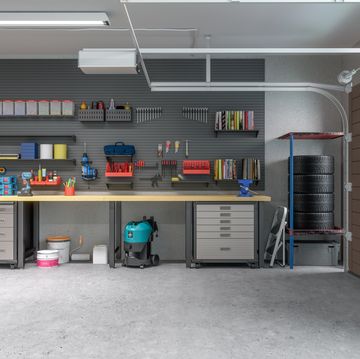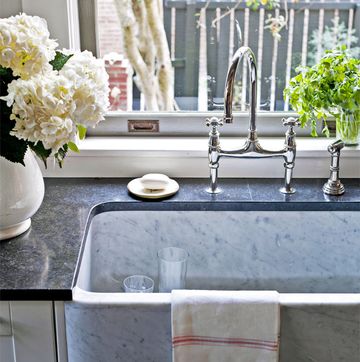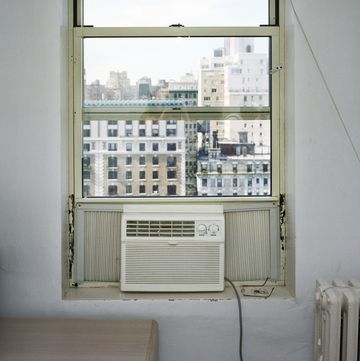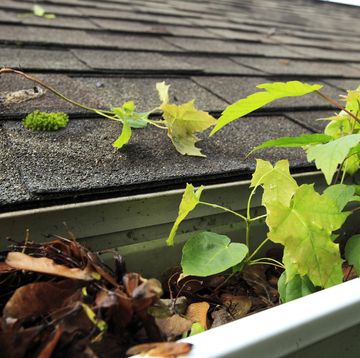After the winter season, you’ll notice that the concrete steps on your front porch or back patio have started to fall apart, corners have chipped off, and some of the sides of the foundation are crumbling. Add repairing your concrete steps to your spring cleaning checklist because it's a safety hazard and reduces your curb appeal. Before you decide to call a handyman, which will cost you between $250 between $700 according to Angie’s List. You can roll up your sleeves and do a DIY to fix your concrete steps with a fast-setting concrete mix. It costs less than $10 and dries in a few hours.
This type of DIY is labor intensive and messy, so wear clothes you don't mind messing up or put on a coverall. You can get all of the supplies you need at your local hardware store. And they are worth the investment because you'll need to perform annual maintenance on your concrete steps.
Materials
- Chisel
- Hammer
- Industrial brush
- Shop vac
- Rag
- Concrete bonding adhesive
- Fast-setting concrete mix
- Rubber gloves
- Safety goggles
- Hoe
- Bucket
- Steel trowel
- Level
- Concrete edger
- Sponge
- Spray bottle with water
- Concrete sealer
Step One: Remove Any Crumbled Concrete
Begin by removing any cracked or chipped concrete—so that you have a surface free of debris to work on. Wedge the chisel into the cracked areas and then place the hammer on top of the chisel and hammer it until the broken pieces fall off.
Step Two: Brush Away Debris and Vacuum Dust
Next, sweep away any broken concrete with your industrial brush. Make sure to get into the little grooves to remove any small stones. Once the big pieces of concrete are removed, use the shop vac to remove dust from the area. Lastly, spray the surface with water. For the new concrete to bond with the old, the surface needs to be wet.
Step Three: Apply Concrete Bonding Adhesive
The concrete bonding adhesive allows the old concrete to connect with the new. Think of it as the glue to mold the old with the new. Generously apply it to the surface with a rag or paintbrush. It takes about two to three hours to dry—so this is a good time to grab some lunch and binge-watch a couple of shows.
Step Four: Prep the Quick Dry Cement
In this next step, you want to prep the concrete properly—it will dry fast, so once you make the concrete, be prepared to apply it with some speed.
Before you put on your face mask, gloves, and safety goggles. Prepare the quick-dry cement by hand by pouring the fast-setting concrete mix into a plastic mortar tub. Create a chasm in the middle of the concrete and pour two-thirds of the recommended amount of water. Begin by mixing it with a hoe while mixing, add in the remaining water from your bucket. Don't over-water your concrete because it will not bond properly. When finished, the concrete should look like wet mud and won't crumble in your hand.
Step Five: Apply the Quick Dry Cement
You'll need to move fast now that you have your cement prepped and begin to apply it to the chipped and damaged areas with your trowel.
Step Six: Smooth and Remove Excess Concrete
Use your concrete edger to scrap off any concrete lumps, followed by a wet sponge to smooth the surface. If there are any divots or shallow parts, use the trowel and fill those gaps with concrete. Then re-use your sponge to smooth out the surface. Once the surface looks complete, use a level to confirm it's flat.
Step Seven: Let the Concrete Dry
Generously wet the surface again with a spray bottle. The concrete needs to remain moist, so let it dry for 24 hours. The longer the material gets to set and dry, the firmer the concrete bond.
Step Eight: Apply a Concrete Sealer
Apply a concrete sealer a month after the repair to the concrete has cured properly. The temperature should be above 50 degrees, and the concrete surface should be dry and clean. Follow the instructions on the concrete sealer package, and you're all set.
Follow House Beautiful on Instagram.

Angela Belt is the contributing Assistant Shopping Editor at House Beautiful. She's also an interior designer and is the host of her own podcast, The Mood Board. When it comes to design, she's an esteemed expert with some of her work also appearing in HGTV, Better Homes & Gardens, The Washington Post, and more.












